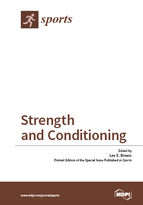Strength and Conditioning
A special issue of Sports (ISSN 2075-4663).
Deadline for manuscript submissions: closed (31 December 2015) | Viewed by 96561
Special Issue Editor
Special Issue Information
Dear Colleagues,
This Special Issue will provide knowledge related to strength and conditioning for fitness and sport performance. It is designed for those interested in the many topics that concern strength and conditioning, in relation to advanced scientific inquiries of program design, the periodization of training and anaerobic strength, and power testing. Topics will focus on postactivation potentiation, neuromuscular adaptations to resistance training, motor unit recruitment, and muscle fiber types. Emphases will be placed on investigations leading to increased human performance through manipulation of bioenergetics, biomechanics, and the endocrine system. Additionally, practical applications to training and performance will be stressed, so as to influence daily exercise protocols.
Prof. Dr. Lee E. Brown
Guest Editor
Manuscript Submission Information
Manuscripts should be submitted online at www.mdpi.com by registering and logging in to this website. Once you are registered, click here to go to the submission form. Manuscripts can be submitted until the deadline. All submissions that pass pre-check are peer-reviewed. Accepted papers will be published continuously in the journal (as soon as accepted) and will be listed together on the special issue website. Research articles, review articles as well as short communications are invited. For planned papers, a title and short abstract (about 100 words) can be sent to the Editorial Office for announcement on this website.
Submitted manuscripts should not have been published previously, nor be under consideration for publication elsewhere (except conference proceedings papers). All manuscripts are thoroughly refereed through a single-blind peer-review process. A guide for authors and other relevant information for submission of manuscripts is available on the Instructions for Authors page. Sports is an international peer-reviewed open access monthly journal published by MDPI.
Please visit the Instructions for Authors page before submitting a manuscript. The Article Processing Charge (APC) for publication in this open access journal is 1800 CHF (Swiss Francs). Submitted papers should be well formatted and use good English. Authors may use MDPI's English editing service prior to publication or during author revisions.
Keywords
- strength
- power
- hypertrophy
- speed
- endurance
- periodization
- program design
- anaerobic







